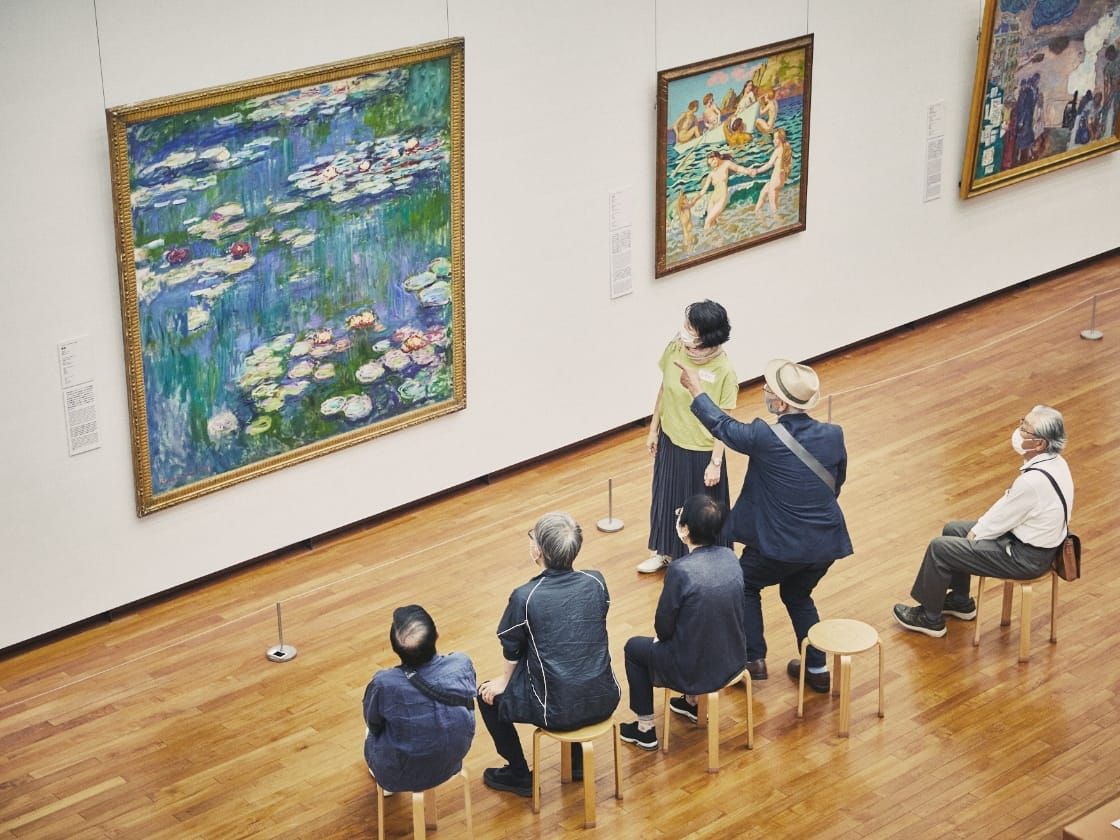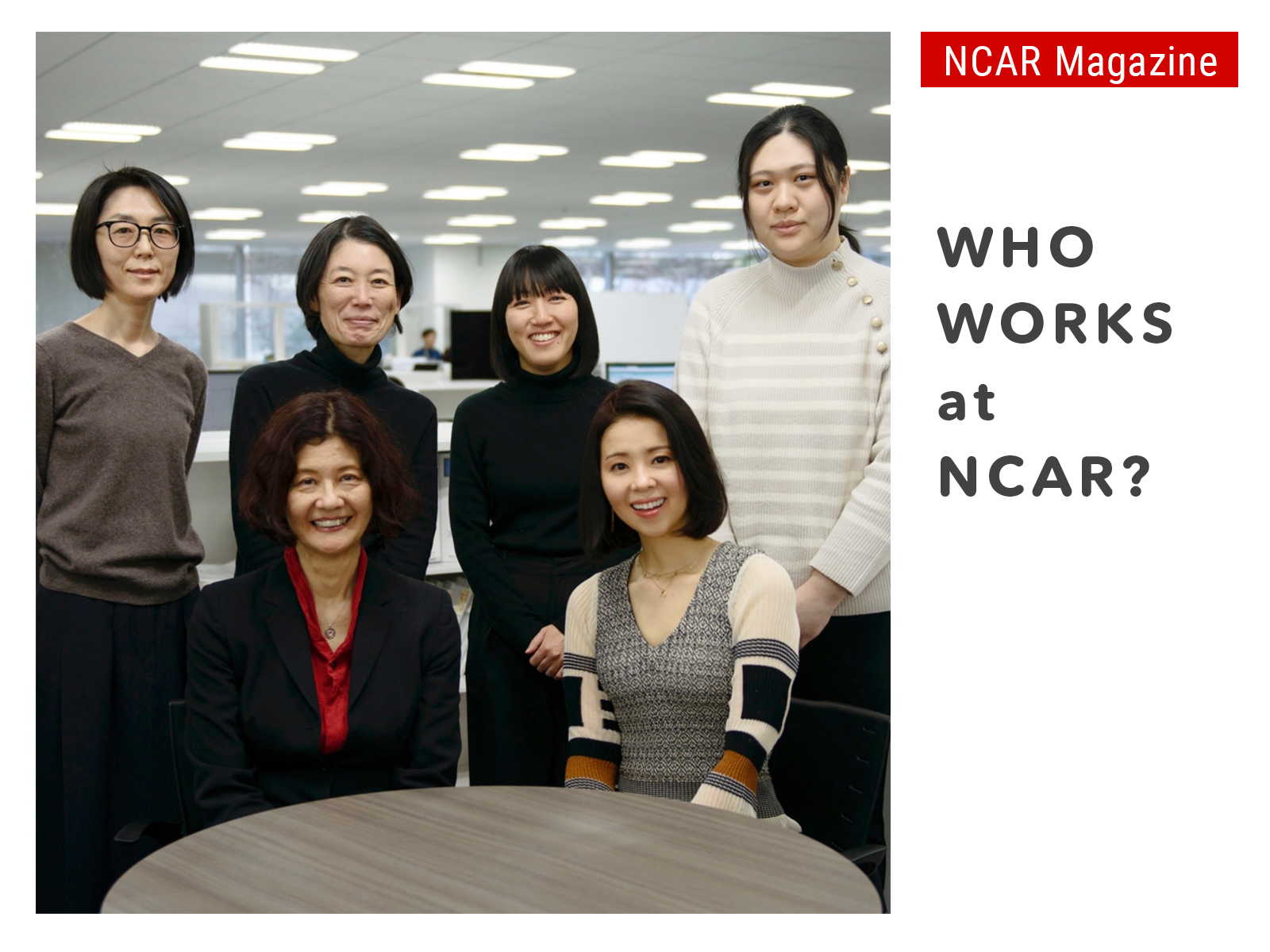WHO WORKS at NCAR? is a series of articles introducing the people who work at the National Center for Art Research (NCAR). This second installment focuses on the International Relations Group and its initiatives in the areas of “connecting” and “expanding,” which are part of NCAR’s mission of “Connecting, Deepening, and Expanding Art.”
(Photo, clockwise from lower right: Senior Program Officer Masumi Kaoru, Head of International Relations Okabe Miki, Administrative Assistant Chiba Miwa, Associate Program Officer Iwamoto Fumiwo, Associate Program Officer Saito Chie, and Assistant Program Officer Chenyuan Huang)
Three programs that illustrate the role of the International Relations Group
The International Relations Group is involved in a wide range of activities aimed at lifting the value of Japanese art internationally. In order to build a network of national museums and other major art museums overseas, the group organizes and facilitates study tours overseas for representatives from the Japanese art world, and also invites museum and festival directors and curators from overseas to perform research on the art scene in Japan. To spread the word about Japanese art, in addition to providing support to Japanese artists participating in international exhibitions held overseas, the group also translates important literature associated with postwar Japanese contemporary art into English and publishes them online. It is also involved in international symposia based on this literature. We talked to four staff members about the workings of the International Relations Group. From among the wide range of the group’s activities, we focused on three programs that are already underway in FY 2023.
Profiles
Okabe Miki, Head of International Relations
After working as a curator at a public art museum, became involved in international exchange, focusing on exhibitions introducing Japanese art from the classical to the contemporary to people overseas. In current position since April 2023.
Masumi Kaoru, Senior Program Officer, Deputy Head of International Relations
Has been involved in supporting artists through galleries and public institutions, in planning and running cultural projects, and in international exchange. In current position since June 2023.
Saito Chie, Associate Program Officer
Has been involved in international exchange and in the planning, operation, and public relations for projects at cultural institutions including public art museums. In current position since June 2023.
Iwamoto Fumiwo, Associate Program Officer
Has been involved international exchange and public relations at public theaters and art museums. In current position since December 2023.
Forging connections through NCAR Study Tours
The International Relations Group offers the NCAR Study Tours with the aim of building an enduring network between art experts inside and outside of Japan. The first location visited was South Korea in FY 2023. A total of seventeen representatives from national and private museums, universities, and art spaces operating under a variety of models participated in the tour. They come from a range of backgrounds of specializations, but they share a focus on contemporary art.
The participants were provided with support for major expenses such as the cost of travel and accommodations, and they were afforded help in arranging on-site visits and network-building opportunities. Over the course of five days, they visited three cities (Seoul, Ulsan, and Busan) with the aim of observing trends in Korean contemporary art from a variety of perspectives. They visited national museums including the National Museum of Modern and Contemporary Art, Korea; Seoul Museum of Art; and the Busan Museum of Contemporary Art; as well as private (corporate) museums including the Leeum, Samsung Museum of Art and the Amorepacific Museum of Art.
Okabe Miki, Head of International Relations, explains the intent of the tour, saying, “One of the issues that NCAR needs to tackle is collaboration among national museums in Japan. We are also collaborating with national art museums in other countries. We launched this kind of program with the goal of building close relationships involving not only national museums but also other art experts inside and outside of Japan. Going forward, we hope that it will lead to joint research, collection exchanges, and joint exhibitions.”
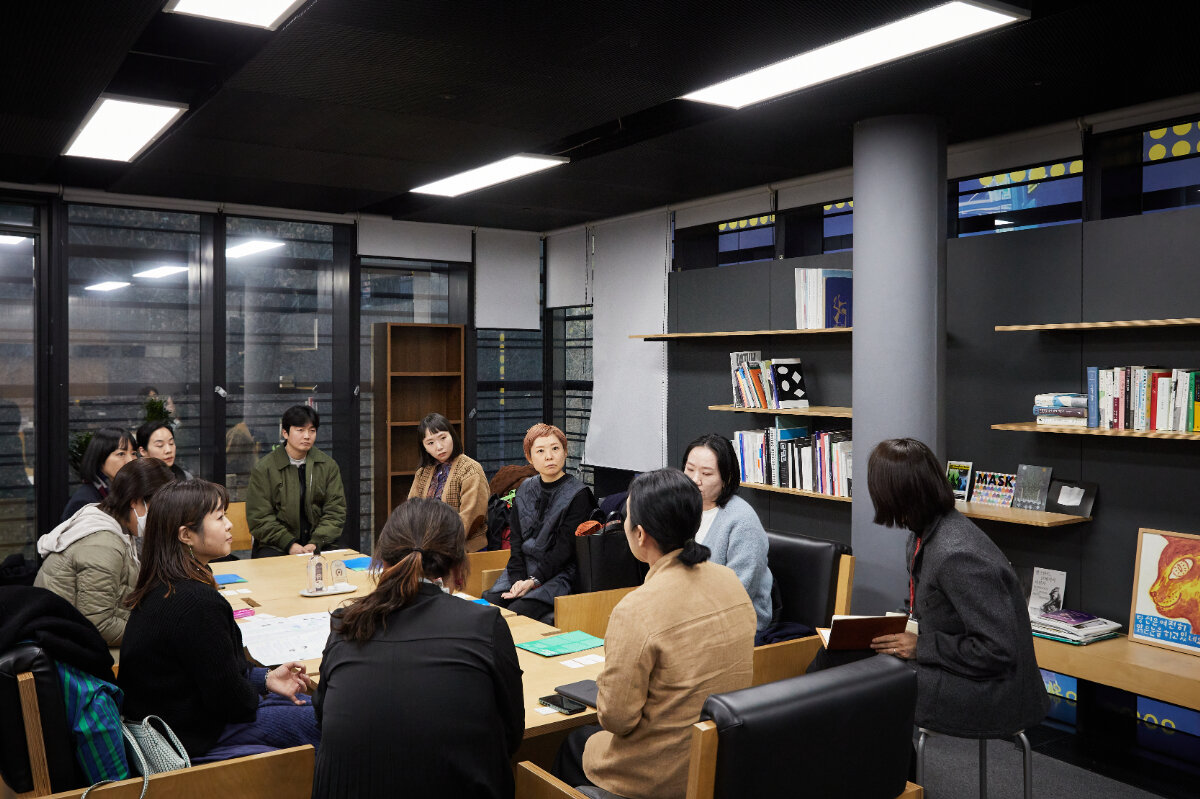
November 2023, 1st NCAR Study Tour (Korea) / Sharing ideas at the Nam June Paik Art Center
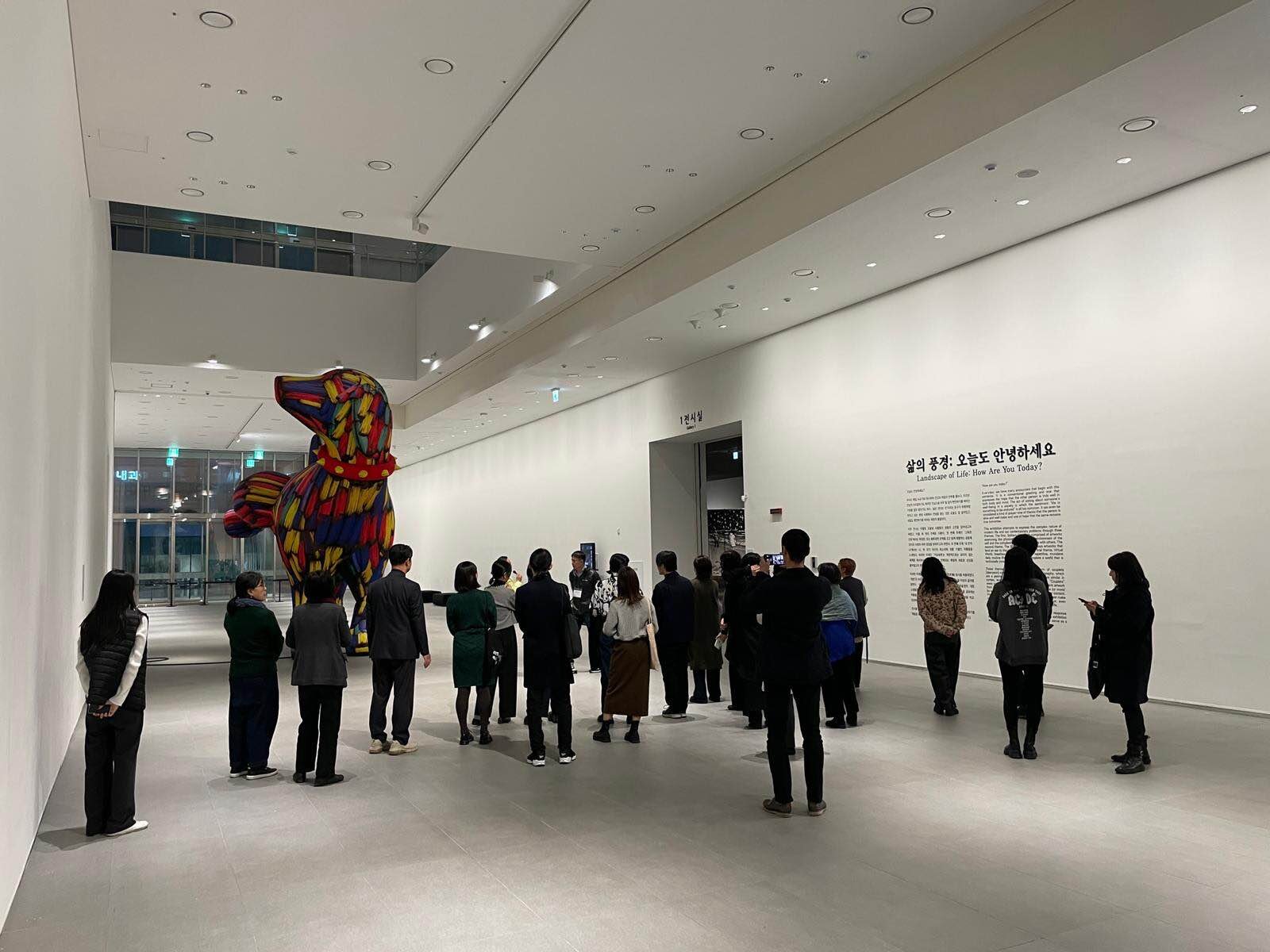
November 2023, 1st NCAR Study Tour (Korea) / Touring the exhibits at the Ulsan Art Museum
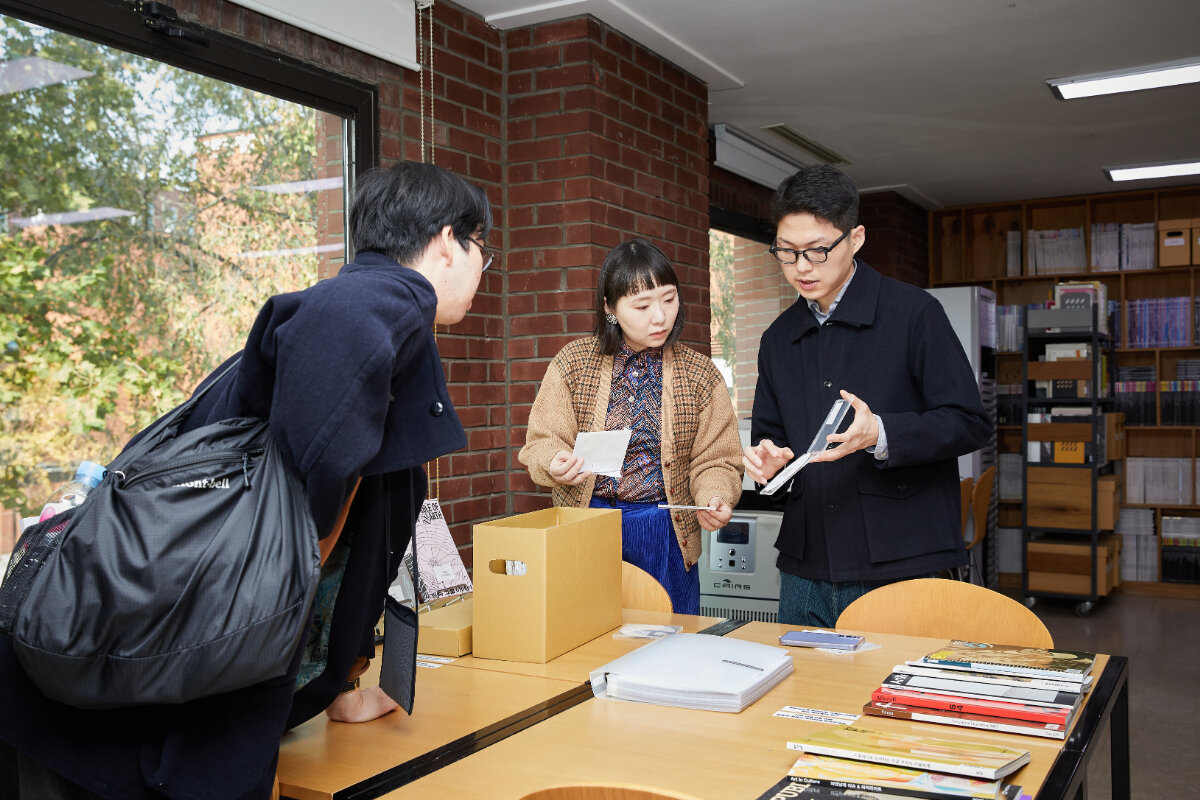
November 2023, 1st NCAR Study Tour (Korea) / Visiting the archives at the ARKO Art Center
When visiting the museums, the focus was on meeting as many experts as possible, including curators, conservators involved in the preservation and restoration of works, and archivists who manage information and materials about works and artists. By visiting museums that operate under models ranging from national to private, but mainly focused on contemporary art, the International Relations Group put together a program that allowed participants to see what these museums have in common with Japanese museums and how they differ, and also how the positioning of a museum varies depending on the city where it is located. Saito Chie, who was involved in planning the study tour and led it along with Okabe, says that the five-day program was designed with the idea of creating many opportunities for the kind of physical interaction that was difficult during the COVID-19 pandemic.
“On the fourth day of the tour, we visited the collection storage and conservation facility of the National Museum of Modern and Contemporary Art, Korea (MMCA) in Cheongju. The enormous building is a renovated former tobacco processing plant, and the first and third floors are open storage that the general public can view free of charge. I was surprised by the size of the facility. Moreover, I heard that it displays not only works in the collection, but also works by Korean artists that have been collected by Art Bank. The conservation and restoration rooms, staffed by conservators and scientists who specialize in analyzing works of art, also restore works from the outside and take in trainees. We were able to exchange ideas with other participants about the state-led effort to build an environment for everything from the collection of these works to conservation, restoration, exhibition, and education, and this left a strong impression on me.”
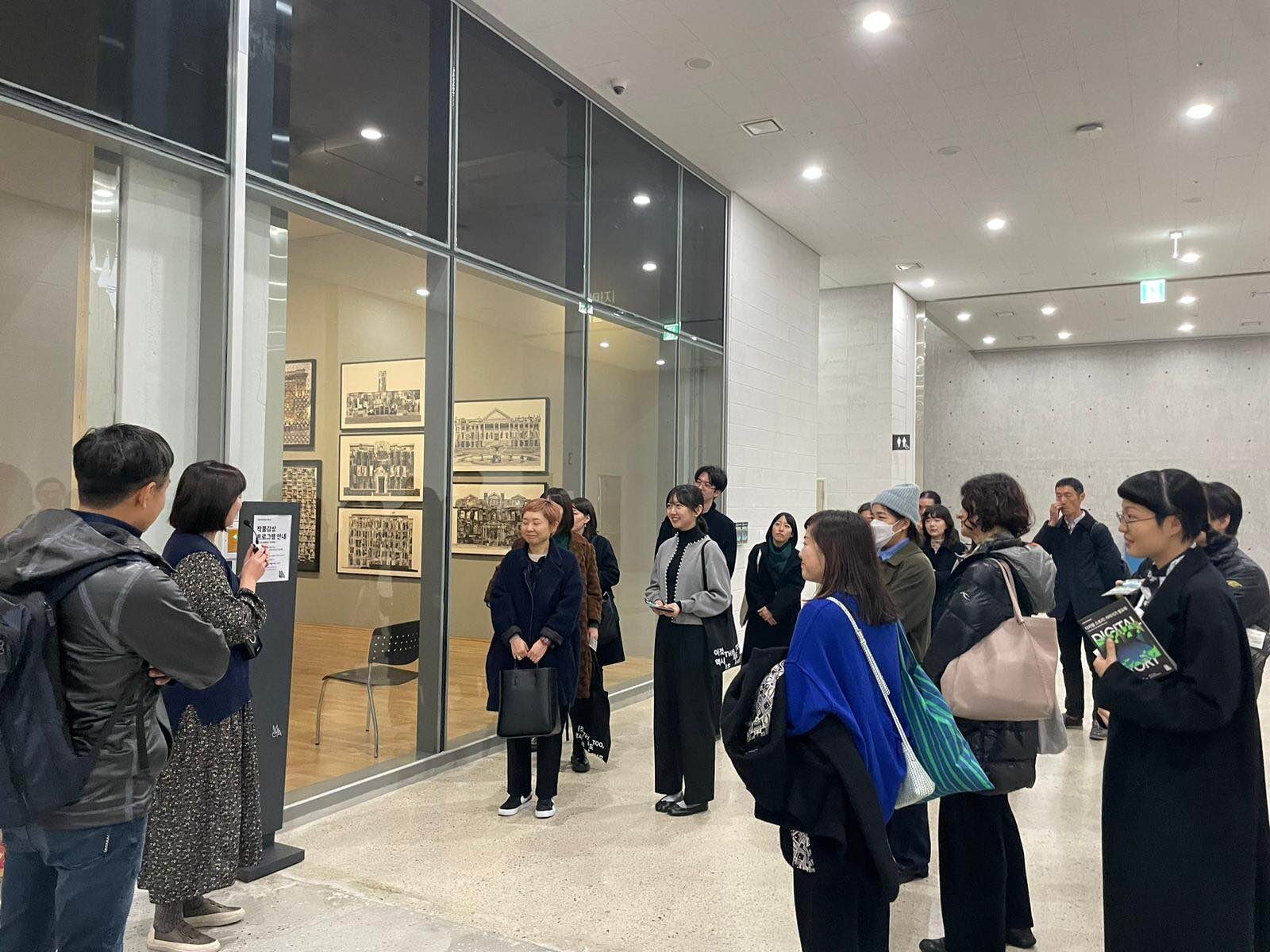
November 2023, 1st NCAR Study Tour (Korea) / Touring the open storage at National Museum of Modern and Contemporary Art, Korea (MMCA Cheongju)
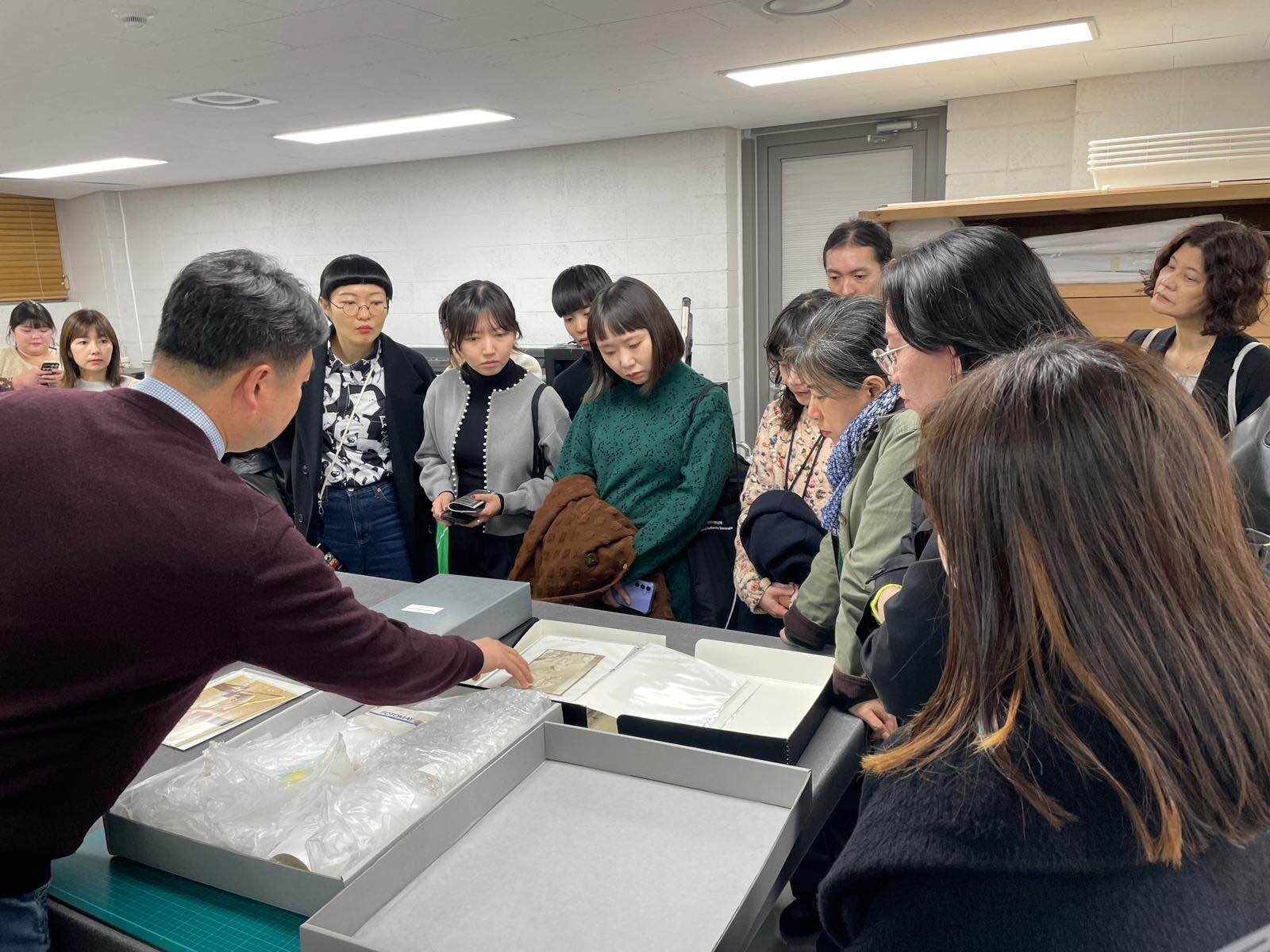
November 2023, 1st NCAR Study Tour (Korea) / Visiting the conservation and restoration rooms at National Museum of Modern and Contemporary Art, Korea (MMCA Cheongju)
At the locations visited, tours were tailored to the expertise and interests of the tour participants and there were opportunities for interacting with experts. Those involved also sounded out each other about concrete projects for collaboration. After returning to Japan, the opportunities for exchanging ideas continued. Tour participants visited each other’s museums, and Korean museum staff visited the art museums that had sent people on the tour, so it appears that the connections have steadily grown.
The 2nd NCAR Study Tour will go to North America. The tour will start in late February with a visit to the National Gallery of Canada in Ottawa and then go on to visit a number of museums in Montreal. It will then proceed to the US. After visiting New York and Philadelphia, the tour will go to Washington DC, where participants will visit a variety of facilities including the National Gallery of Art and the National Museum of Asian Art, which is part of the Smithsonian Institution. The planned itinerary is eleven days long, ending in early March.
“Understanding the demand for Asian art—including Japanese art—outside of Asia and how it is presented is a key point to consider when bringing Japanese art to people overseas,” says Okabe.
Supporting Japanese artists on the world stage
Biennales, triennales, and other international art festivals held around the world are important venues for artists to present their works. They are valuable opportunities for increasing international recognition for Japanese contemporary art. The NCAR Artist Support Program officially starts in FY 2024. It will provide financial support to Japanese artists participating in international art festivals outside Japan. Via the organizing entities, it will provide 3.5 million yen in support for a single artist and up to 7 million yen when there are multiple artists. In association with this program, the International Relations Group provides artists and art professionals with support at multiple levels. For example, in advance of international exhibitions, the group invites directors and curators to Japan to research Japanese artists, thereby helping such artists establish a stronger presence in an international context. The group also produces bilingual videos of interviews with exhibiting artists and recordings of the artists’ creative processes and make them available to the public.
As a precursor to this new program, in FY 2023 the International Relations Group is supporting a total of eighteen artists who are showing works at seven international art exhibitions, beginning with the São Paulo Biennial in Brazil, which opened in September 2023, and ending with the Venice Biennale in Italy, which opens in April 2024. Masumi Kaoru, Deputy Head of International Relations explains the process for supporting artists at the Shanghai Biennale, which opened in November 2023 at Power Station of Art, the contemporary art museum in Shanghai that is housed in a renovated power plant.
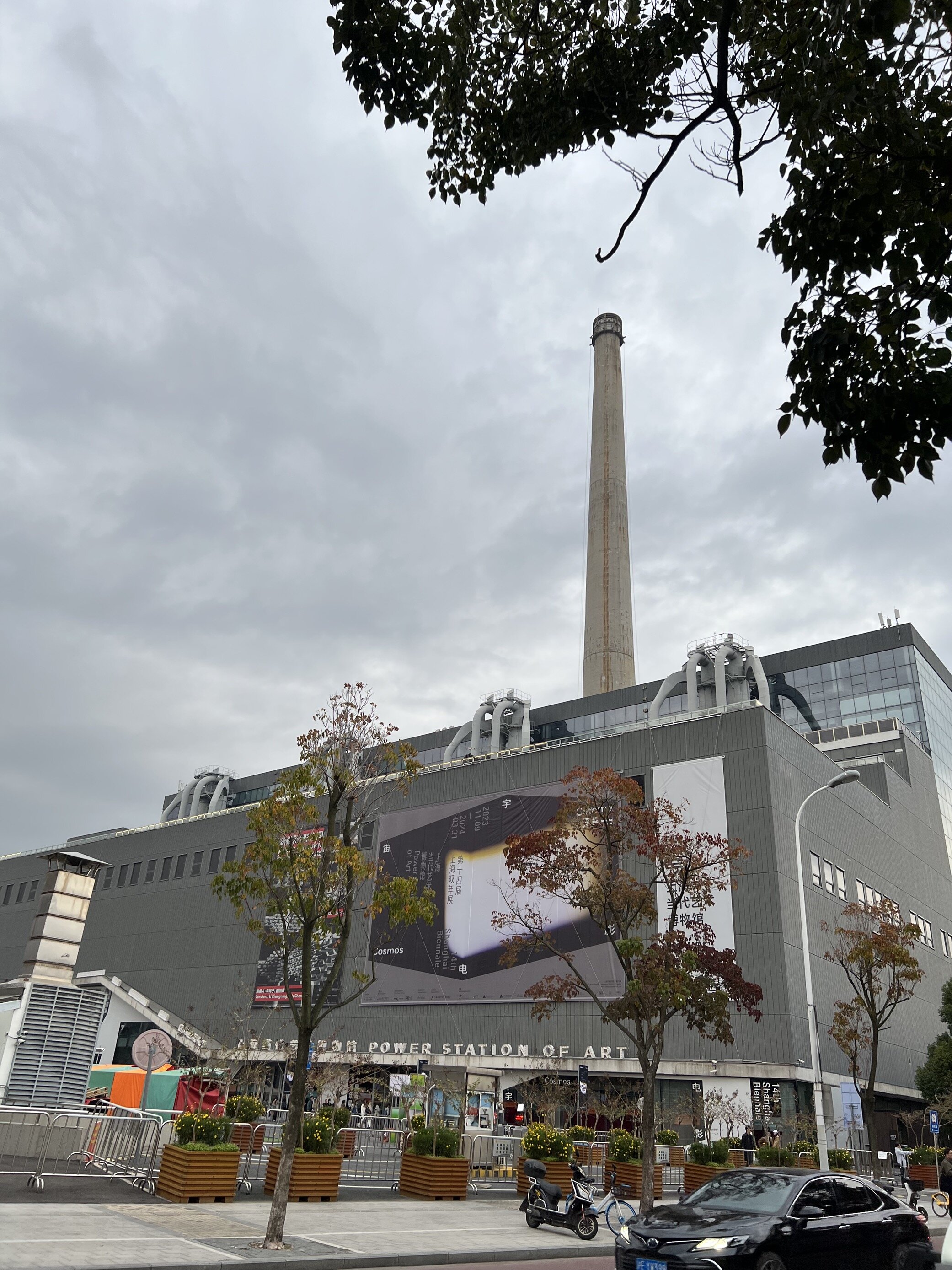
Power Station of Art, venue for the 14th Shanghai Biennale
“The artistic director was announced in May 2023, and the Biennale opened in November, so things moved much faster than usual. However, I knew the artistic director, Anton Vidokle, from my previous job, so I immediately reached out to him to let him know that we would be happy to offer support if he were considering exhibiting works by Japanese artists. As a result, a young member of his curatorial team, Hallie Ayres, was sent to Japan carry out research, and I helped by setting up and attending meetings with her. Ultimately, all of the artists she researched participated in the Shanghai Biennale, so I was happy to see that this research immediately bore fruit in the form of works exhibited at the Biennale.”
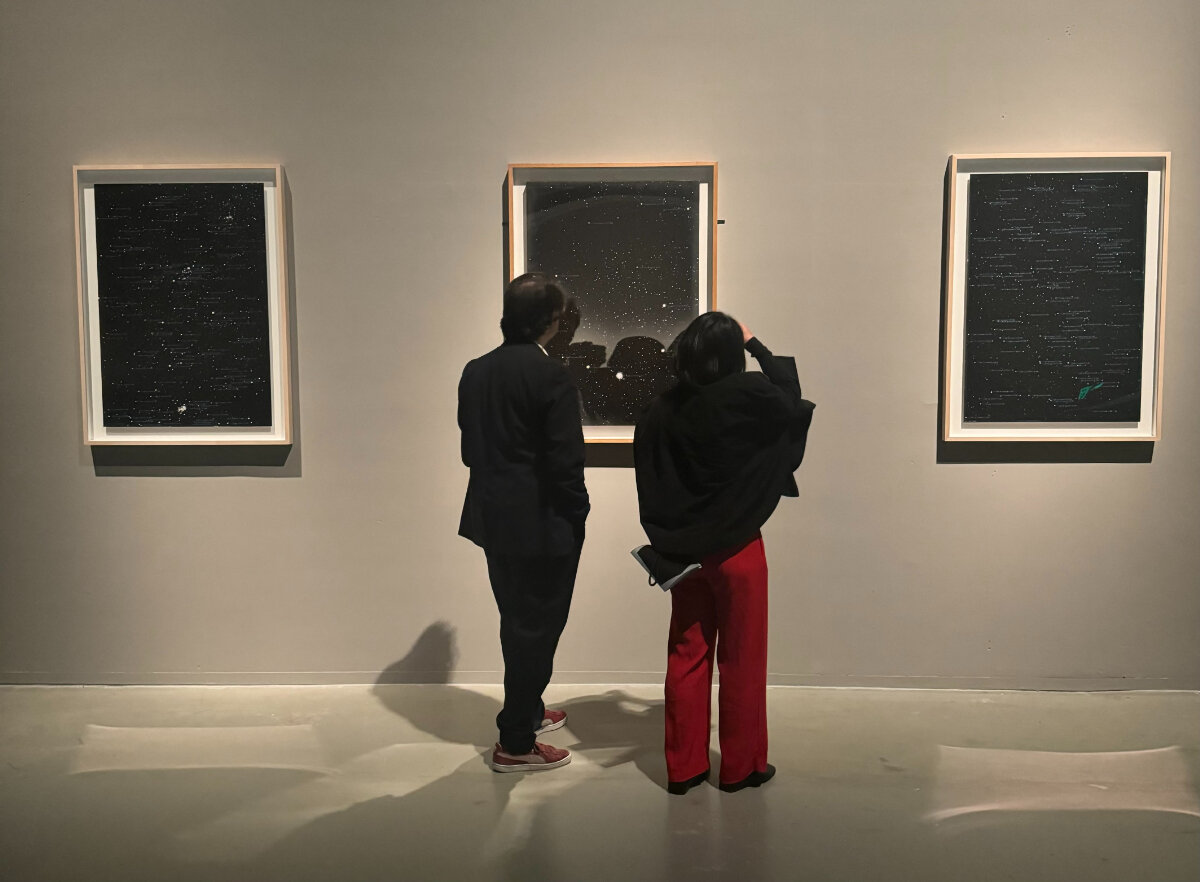
14th Shanghai Biennale: Kawaguchi Tatsuo, COSMOS series (1974-75)
14th Shanghai Biennale: Sasaoka Yuriko, Gyro series (2023)
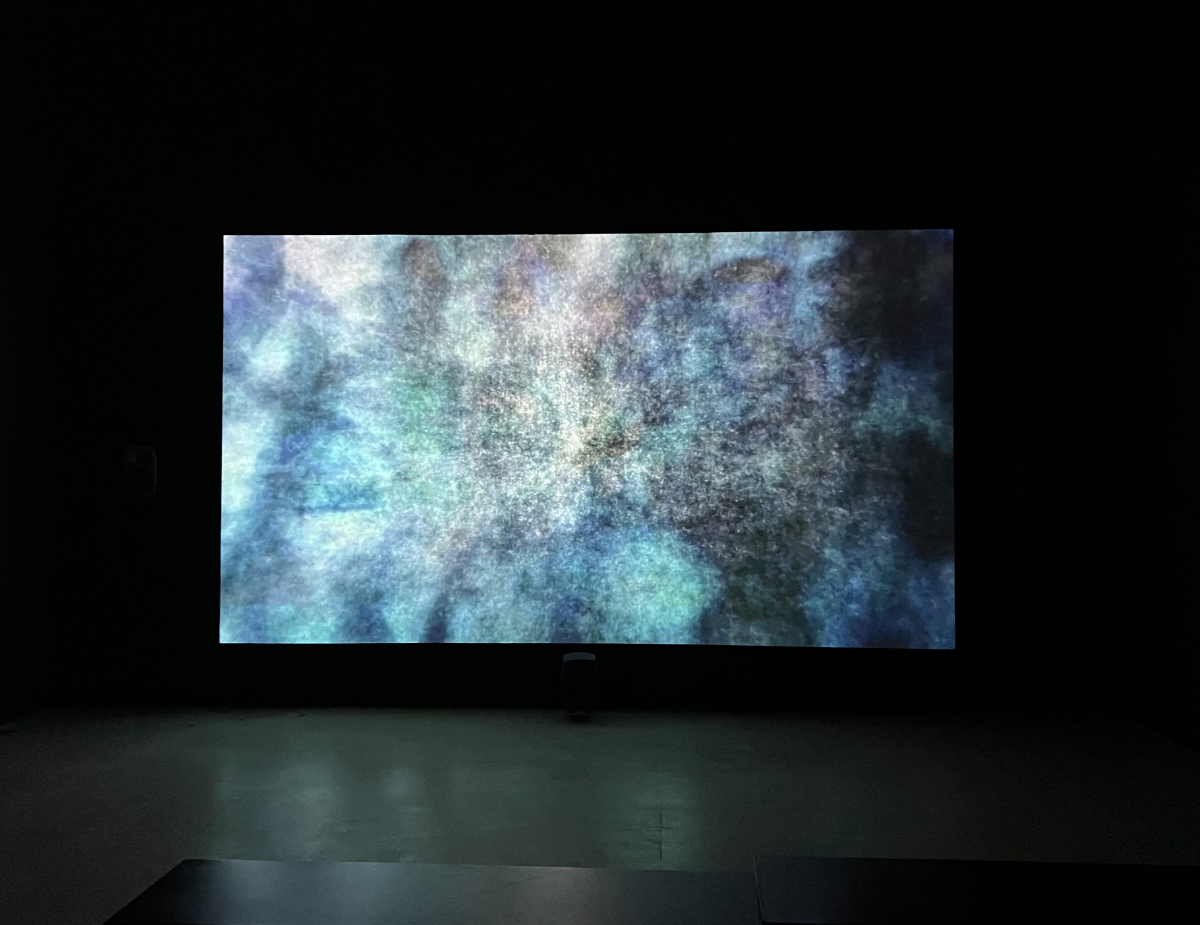
14th Shanghai Biennale: Makino Takashi, Anti-cosmos (2022)
The objective of the Artist Support Program is to boost the presence of Japanese art on the world stage by supporting the exhibition of works by Japanese artists overseas. It is the organizer of the international art festival who applies for financial support. However, unlike subsidies that are generally paid after a project is executed, under this program it is also possible for payment to be made in advance as an estimated amount before the project is executed. Furthermore, exhibition expenses can be paid directly to the artist rather than to the festival organizer. Taken together, this gives the program flexibility and speed in providing support.
Masumi goes on to say, “The Thailand Biennale opened in December 2023. The creative process of one of the exhibiting artists, Kido Ryusuke, was captured on video over the course of two months, and I had the rare experience of attending the filming of the final stage of the process in person. By witnessing the earnest interactions between an artist dedicated to his work and the local staff who were supporting him, and the challenges they faced, I was able to see for myself how the assistance provided by NCAR facilitated an expansion of artistic practice.”
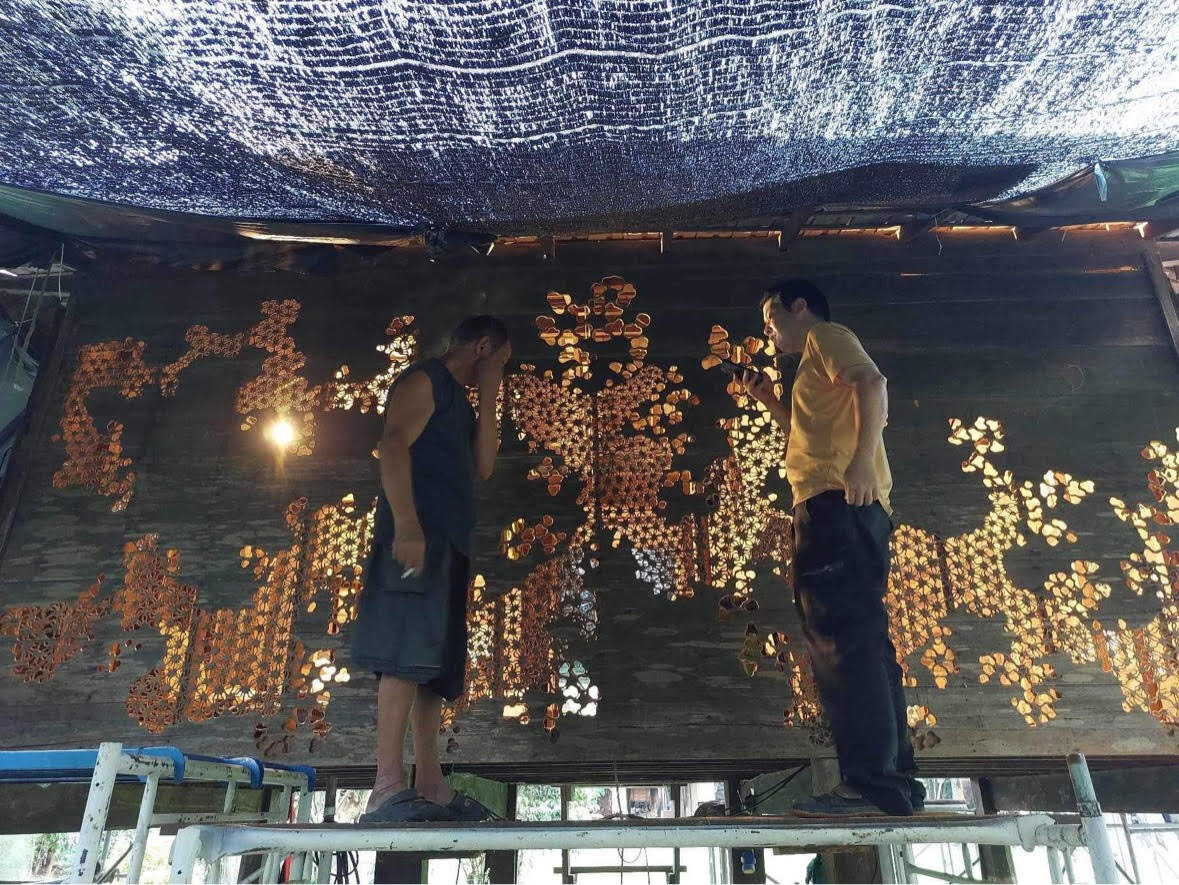
Thailand Biennale, Chiang Rai 2023: Kido Ryusuke creating Inner Light (2023) (R: Kido Ryusuke; L: collaborator Kamchan Yano)
The Artist Support Program officially starts in FY 2024, and it accepts applications twice each year. To avoid the risk that some artists would miss out on support due to timing issues if applications were accepted only once a year, NCAR decided to open the door wider to offer more opportunities to apply for funding to exhibit at international art festivals.
Symposium and workshop to facilitate international exchange
To bring Japanese art to the world, the International Relations Group also offers programs designed to provide opportunities for Japanese and foreign experts to come together and interact and share ideas in order to deepen their knowledge on themes that are common throughout the world. The first National Center for Art Research International Symposium and Workshop will be held in March 2024. It will be a three-day program on the theme of "Museum and Research: What does it mean to ‘deepen’ art?"
NCAR aims to not only conduct research in specialized fields, but also contribute to the overall enrichment of museum activities in Japan. Therefore, we believe that research to "deepen" art is an essential function performed by museums and art professionals. In the “workshop” part of the “International Symposium and Workshop,” there will be presentations and discussions about research and archival work, and related issues, from the perspective of artists, curators, researchers, and archivists.
For example, in the Archive Case Studies Session, we plan to present case studies about archives of artworks and other materials at museums inside and outside of Japan, and along with sharing issues encountered in the field, there will be a discussion of the future prospects for showing and using what is held in these archives. In the Artist Session component, artists who base their creations on research and fieldwork will take the stage to share issues that arise during the research process and in the field while they are creating. They will also discuss topics such as how to use the research resources obtained during the process of creation. The organizers are planning other sessions, such as Curatorial Session and Research Activities, aimed at spurring in-depth, multi-layered discussions about art research that span multiple standpoints and perspectives.
On the final day of the International Symposium and Workshop, there will be a tour of the 8th Yokohama Triennale. The main festival venue is the Yokohama Museum of Art, which is set to reopen after renovation.
Program Officer Iwamoto Fumiwo discusses the program, saying, “I believe that one of the roles of the International Relations Group is to contribute to the ‘connecting’ part of NCAR’s mission. I hope that this program will function as a platform that brings all sorts of people together, boosting connections from the individual level to a broader scale as it gives rise to cooperative relationships with peer art institutions overseas and advances collaborations among art museums in Japan.”
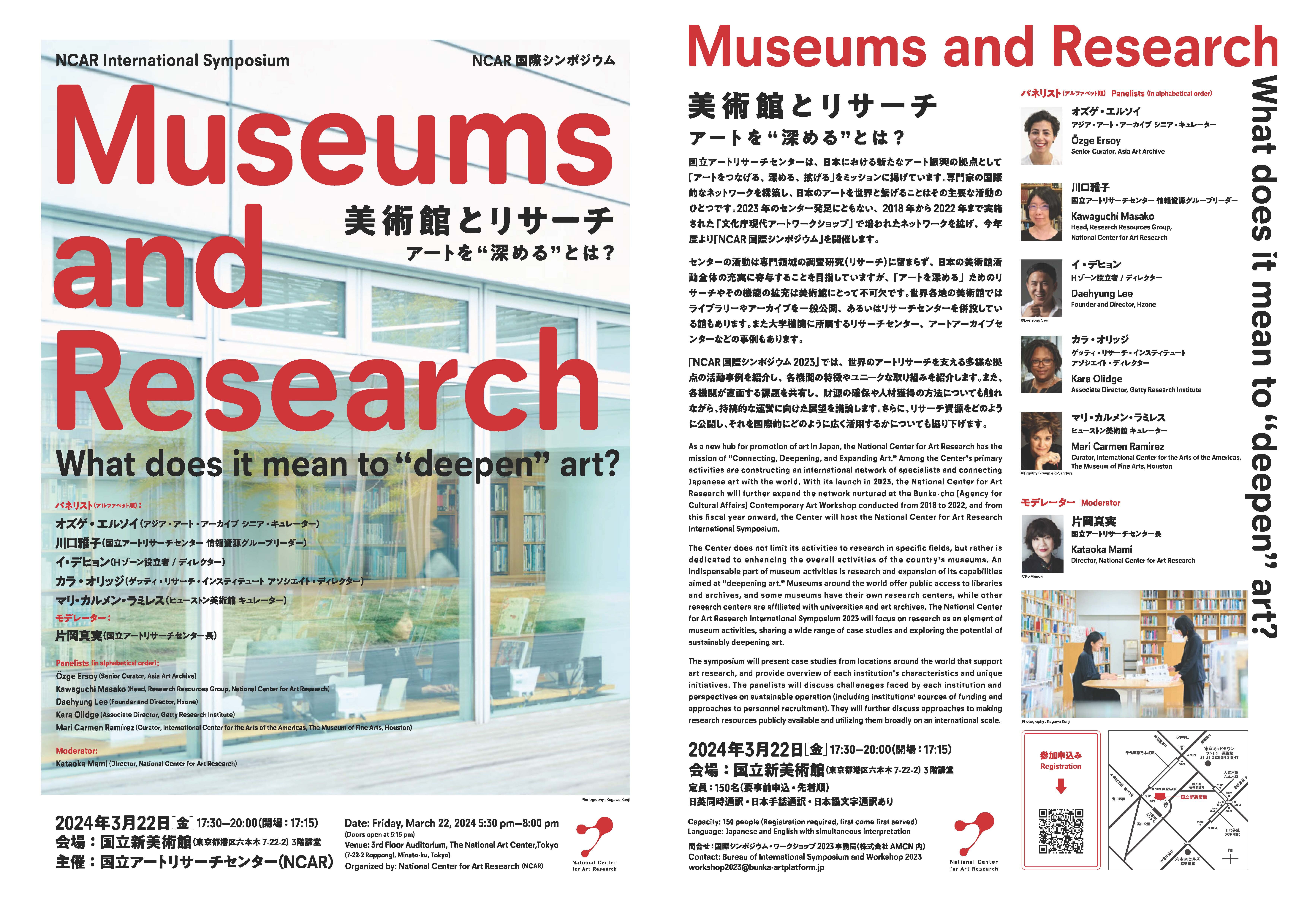
Flier for the March 2024 NCAR International Symposium and Workshop
Head of International Relations Okabe talks about the future of the International Symposium and Workshop.
“This is the first symposium led by the International Relations Group, and we are working hard to create a forum where there are sufficient opportunities for participants to exchange information and engage in discussions with each other. Next year and beyond, while addressing issues such as “What is the role of art and museums in the post-COVID world,” I would like us to work to build further upon the results of this symposium and give some part of it back to society.”
In addition to the programs discussed above, there are joint projects with research institutions (including universities) and museums that are already underway, and going forward the group will develop a variety of international programs while continuing to collaborate with other institutions.
The members of the International Relations Group feel good about what they accomplished in their first year (2023) through the study tour and the predecessor of the Artist Support Program. They share Saito's sentiment that “small connections are gradually expanding.” However, at the same time, they recognize that it will take some time for the results to become visible. A lush forest grows from the accumulation of small efforts over time. With this picture in mind, the members of the Group are working to raise the visibility of Japanese art internationally.
(Interviews, text, and group photo by Nakajima Ryohei)


